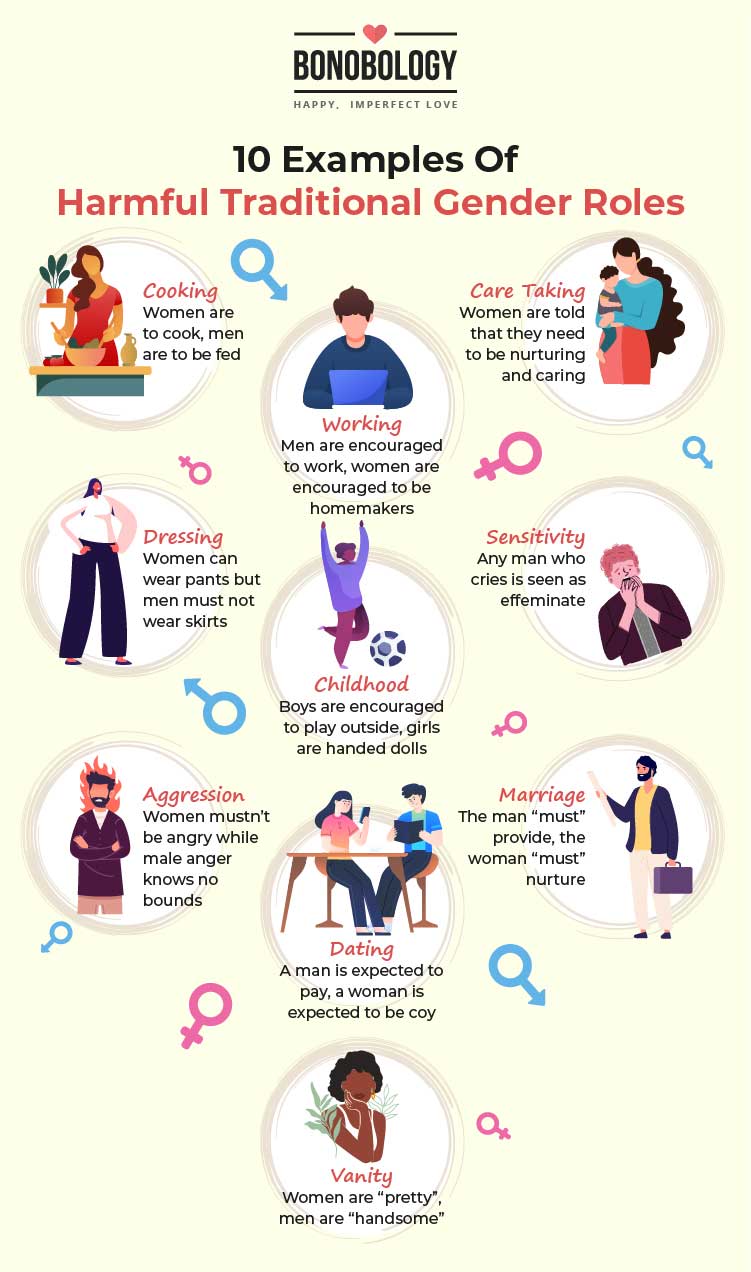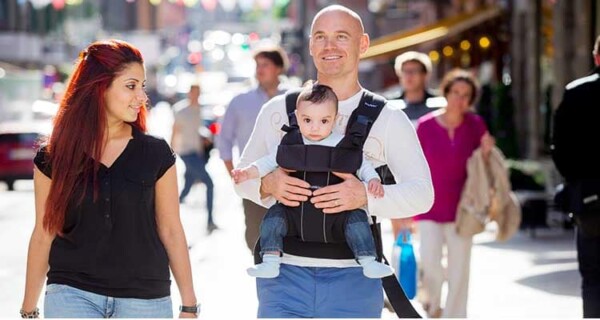What are traditional gender roles? What is the ideal man like? Is he tall, strong, stoic? What about the ideal woman? Is she petite and soft-spoken? Is she nurturing? When I asked you this question, a similar answer may have entered your mind. This is exactly what traditional gender roles are. Rules and principles on how to do the things required to be the ideal man or woman. In this article, we will talk about 10 examples of traditional gender roles.
These roles were never really required and were solely created as a patriarchal tool to oppress and control the way a person thinks, acts, and feels. An important thing to remember is that traditional gender roles were not brought into existence a few hundred years ago. Gender roles are as old as civilization itself, and were thought to be vital for human survival back then. This goes as far back as the stone age, where the latest technology consisted of things like sharp stones and bowls1. Getting a meal for your family was not a thirty-minute trip to the nearby store, it was a three-day hike in the forest and you could still come back empty-handed. Life back then was not as easy as it is today. And so gender roles were born.
Men and women both recognized their so-called strengths and weaknesses to help each other survive. Each gender role was just as important as the other. At that point, gender roles were not meant to create gender equality but to uphold gender norms. It was recognized that differences between male and female bodies did exist. But they used these differences so that the ‘strengths’ of both genders would make up for the others’ ‘weaknesses’.
However, somewhere along the way, gender roles went from being a tool of cooperation for mutual benefit to a tool used to control and belittle. Now, gender roles are often assigned to people to govern the way they act/think. The psychological impact of traditional gender roles and gendered expectations leave the people limited in their potential. Since their actions are now controlled by what’s feminine and what’s masculine, they may not truly be able to express themselves in the fear of tarnishing the traditional views of gender roles.
Additionally, for transgender people, such roles continue to harm them their entire life. Since they don’t identify as the sex they’re assigned at birth, traditional gender roles make them feel alienated in society. Something that’s completely unnatural to them is forced upon them, often violently. Gender roles in society are inherently damaging to individuals all over the world, and do a lot of harm to each gender. Let’s find out their place in modern society along with 10 common examples of traditional gender roles.
Place Of Gender Roles In Modern Society
Table of Contents
Logically speaking, I have no idea why gender roles were not left in the past. The truth is gender roles are not vital to survival anymore. Not since the Industrial Revolution and the development of medicine. Technology has rendered most gender roles redundant.
Today, people of all genders can live individual lives, they can work, study, explore, and thrive without really needing anyone else. Due to how useless gender roles are in today’s age, there really isn’t a reason we should still believe in them dogmatically. Now the focus is on promoting equality rather than harping on gender roles in society.
While it is true that fewer people are adhering to traditional gender roles today than they did before, they still exist everywhere. Gender roles and stereotypes may be subtle, but they are still quite prevalent, impacting a person’s income, how they are respected/disrespected, accepted/rejected, how people interact with one another at their places of work, their homes, etc. The basic types of gender roles include male gender roles and female gender roles that are followed when it comes to child rearing and household chores.
There isn’t a single aspect of life where people can completely escape gender roles and gendered expectations and stereotypes. Every person is affected differently and some traditional gender roles are more harmful than others.
For example, a woman is still paid 82 cents for every dollar earned by a man. This is a result of the negative gender roles in society that make people perceive women are somehow less capable/analytical while doing the same job as men. This is one of the most unfortunate women stereotypes. The same study finds that female surgeons and physicians collectively receive $19 billion less than their male counterparts.
The benefits of traditional gender roles were always debatable, but have now ceased to exist altogether. Now, the only things they cause are lack of empathy, discrimination, and hatred that lead to multiple biases in the workplace as well as in personal relationships.
It infringes upon a person’s individuality. It oppresses people and forces them to act, think, and feel in a certain way. The problem arises when someone doesn’t fit into a prescribed gender role. Not only does the person feel like they don’t belong and something is wrong with them, but they are also often subjected to ridicule and loss of opportunities.
Related Reading: I Am Now The Stay-at-home Dad And My Wife The Breadwinner; And We Are Making It Work
10 Examples Of Traditional Gender Roles
It is very likely that you have come across someone trying to get you to conform to a certain pattern of behavior and traits. Some of them are more common than others, some of them are more harmful than others. The mention of someone’s gender immediately makes people assume things about their personality.
For example, upon hearing that someone is a woman, people may assume her to be timid, soft-spoken, nurturing, and caring – the so-called feminine traits. Upon hearing that a person is a man, they might envision the most common stereotypes of men, someone who is tall, strong, loud, and unempathetic. Since the traditional male roles in society all revolve around being the physically stronger and emotionally unavailable one, these roles end up causing a lot of harm.
Below is a list of 10 examples of traditional gender roles. Hopefully, this will allow you to notice when someone is trying to endorse or force someone into such gender roles. You can help them come out of their regressive mindset. These might also help you notice lacuna in your own outlook.
1. Cooking – Most common example of a gender role
A woman’s place is in the kitchen. You have probably heard this saying before. Make a list of roles of women in this world and this is the most-followed gender norm example that comes up. This is why cooking tops the 10 examples of traditional gender roles on this list.
From a young age, girls are taught that it is their responsibility to learn how to cook for their future families. A woman who cannot cook will find that a part of society is quickly going to look down upon her. As you might have guessed, this isn’t a role that is traditionally pushed upon men. Movies with traditional gender roles don’t shy away from putting women in the kitchen as well. Such an inherently harmful display of women on the big screen inadvertently shapes the minds of the millions watching them, instilling in their minds that such gender roles are okay.
The portrayal of women as “damsels in distress” often shapes the view of young kids watching these movies. For example, the movie Snow White and the Seven Dwarfs features her being cast away, cooking and cleaning for seven men, only to be saved by a man when danger strikes. Another example of movies with traditional gender roles comes from the hugely popular series Mad Men, which features an advertising agency where women are constantly harassed, belittled, and verbally abused since they’re assumed to be incapable of working as efficiently as men.
The fact remains that everyone should learn how to cook as sexism will not feed you when you’re hungry. The kitchen is not supposed to be a woman’s territory and the garage the man’s. Such roles may have served a purpose back when technology wasn’t as sophisticated and the mindsets were regressive, but it is a pretty outdated traditional gender role to still believe in.
2. Working – Men work outside, women at home
We all know that traditional gender roles dictate that a man should be the one working while the woman stays home. This is one of the most important male gender roles based on the existing stereotypes in the society. You also probably know that this mindset is slowly disappearing as more and more women choose to prioritize their careers. Gender stereotypes even affect the profession someone can join with ease.
When it comes to traditional gender roles affecting professional lives, it was found that women tend to get jobs easier in the nursing or hospitality industry because of their perceived sensitivity – a common classifier of feminine traits. On the other hand, it is far easier for men to start their careers in the field of I.T. or technology because of their perceived analytical skills. This is just one tiny example of how traditional gender roles based on women stereotypes and stereotypes of men still impact a person’s daily life.
For example, according to a study, female students outnumber male students in fields like biology, medicine, and chemistry, but men continue to outnumber women in fields like engineering, computer science, and physical sciences. This acts as a great example of traditional gender roles determining the jobs and studies based on gender.
It’s clear that gender roles in society don’t just end up confirming how people act or express themselves, they have a large influence over the careers that are taken up by people as well. These careers then, in turn, ensure that women are paid less for the same amount of work. And if, god forbid, the wife makes more money than the husband, the ego issues that surface make their lives miserable. These ego issues are also caused because of gendered expectations from the society.
3. Care taking – Comes naturally to women
Nursing and caretaking is another ‘responsibility’ that is placed upon women. This entails seeing to the nurturing needs of the household like cleaning, babysitting, etc. While the importance of nursing in a household cannot be underestimated, placing the entire burden on women is extremely unfair. Women are expected to consider the needs and desires of others before they can think about themselves. And to stay at home to look after the family. This is an example of one of the more harmful gender roles.
This traditional gender role actively oppresses women and teaches them that their needs will always be secondary to men. It is not a coincidence that the role of women is often limited to the jobs that are given lesser importance in society. This, in turn, negatively affects women’s self-esteem. Studies claim that traditional gender roles also end up affecting people’s perceptions of themselves, which might lead them to believe that doing the things that gender roles in society expect them to do, are a part of who they are.
Similarly, since the traditional male roles in society dictate that they must not be overly sensitive, they end up distancing themselves from caring and empathetic behavior. This normalizes women as the only ones who keep sacrificing in a relationship. But if we are talking about promoting gender equality, then care-taking is as much a responsibility of a man as it is of a woman.

4. Dressing –Women wear skirts, men wear pants
This traditional gender role is quite harmful as well. It enforces a particular style of dressing on every individual. It also creates a sense of righteousness within people who believe this to be a norm. This is why almost every region has its own set of traditional gendered expectations when it comes to clothing. Think about it, are Indian women allowed to freely wear shorts, or men allowed to experiment with something as trivial as the colors of their clothes?
If we look at 10 examples of traditional gender roles, then we will see how ingrained dressing is in the human psyche. There is no denying the fact that women have taken to wearing trousers these days but men haven’t taken to skirts yet. So gender norms still exist, isn’t it? What this does is create dissent amongst people and makes one group of people judge the other if they deviate from the ‘norm’, which leads to increased hostility.
This traditional gender role is specifically harmful toward trans people as they can’t express their gender identity fully and safely, like most cis people can. And if they do try to dress in alignment with their gender, they are mocked, bullied, and much worse.
5. Childhood behavior – Boys play outside, girls play with dolls
Gender roles are forced upon kids at a very young age. There is a gendered expectation with boys being expected to play sports and do well in school. If either of these criteria isn’t met, that little child will be a target for disdain at home or even bullying at school. On the other hand, little girls are expected to stay indoors and partake in household activities such as cooking and cleaning.
That’s why, even today, adverts for dolls and dolls houses or cooking play sets are still targeted at little girls, and boys are asked to buy shields, guns, and action figures. While this is just one example of traditional gender roles that is enforced on children, it instills the idea of segregation at a very young age and forces them into a particular lifestyle. They are handed over a list of roles of a woman in the world or of a man in the world, which creates limiting beliefs in children and affects them adversely.
Take their health, for example. It is a common sight to see boys taking to the playground during break times at school, while girls indulge in non-outdoorsy play. This unnecessarily limits the physical health of female children and young adults when they are not encouraged to play, mess around in the dirt, and play sports with friends. It is the responsibility of the parents to avoid parenting mistakes such as raising children with gendered stereotypes, and schools need to follow suit as well.
6. Sensitivity – Men don’t cry, women do
The ability to perceive and show emotion is generally associated with women, while men are supposed to be stoic. This one is detrimental to gender stereotypes in society for all genders. On one hand, since women are expected to be more sensitive and emotional, their opinions or concerns are not taken seriously. Her views are dismissed and if she gets angry, she is said to be overreacting.
On the other hand, men are expected to not show vulnerable emotions. This means that if a man does show normal emotions like sadness, he is presumed to be weak. One has to learn how to date a sensitive man, it is not the base expectation for the man to be sensitive. This particular expectation from a pre-set role of women and men in the society causes all genders to have to hide a variety of their emotions to avoid being ridiculed. It leads to repressed women and angry men.
7. Aggression – Men can be angry, women are docile
This is another example of a traditional gender role that causes a lot of harm in society. Men are expected to behave aggressively. Anger and acts of violence tend to be overlooked because of this, and are even encouraged. We have all heard of plenty of stories of the alcoholic abusive husband. Most men who firmly believe in this principle tend to be violent and abusive and they never truly grow out of it. On the other hand, women are expected to be soft-spoken and subservient. Any display of anger is either attributed to her period or neuroticism.
This particular gender role invalidates emotions and creates a violent atmosphere. The image of a hyper-masculine male is someone who is strong and big, someone who doesn’t display affection, and is somewhat expected to express their anger. This image can often lead to domestic abuse since the traditional gender roles claim that these are just the personalities men and women possess. The benefits of traditional gender roles are hard to come by, and when they can instigate problems as serious as domestic abuse, it’s time to actively challenge any embodiment of traditional gender roles you may see around you.
8. Dating – Men pay on a date
The world of dating is filled with traditional gender roles. We have all heard the common ones, who should pay for the date, who should initiate intimacy and sex. A man should behave a certain way, he should ask a woman out, he should propose. A man should be the decision maker. The woman should follow. She should wait for the man to initiate intimacy. It is she who should carry the lotion in her purse. The woman should wear more feminine clothes to look attractive. The list is never-ending.
What’s truly devastating though are its implications. There are so many traditional gender roles when it comes to dating that it actually gets quite difficult to find a partner. Moreover, they hide a person’s true personality irrespective of their gender. No one is really sure of the unwritten rules of dating anymore. These gender roles only serve to make dating harder than it already is.

9. Marriage – Man is the provider and protector
By now you have probably guessed that there isn’t a single aspect of life that has not been tainted by gender roles. In a marriage, traditional gender roles are strictly defined. The husband is supposed to be the provider, he is supposed to be the one who always makes sure that the bills are paid and the family has all that it needs.
The wife needs to take care of the domestic part of the household. It is her job to make sure that there is food on the table, the household is run perfectly, laundry is done on time, and that everything is always clean and organized. Both these roles are very important, but marriage is a partnership, vs just a relationship. Both partners need to bear responsibility. Trying to follow traditional gender roles in today’s society leads to unhappy and problematic marriages. Moreover, women’s role in society can not be limited to domestic life.
Related Reading: Paying For The Wedding – What’s The Norm?
10. Vanity – Women are pretty, men are handsome
Let’s talk about being pretty. What does pretty mean? If you believe in traditional gender roles, a pretty woman is someone who is petite, has a sharp face, or has various other attractive physical features. For men, it is someone who is tall, muscular, and probably has a few scars. This is probably one of the most discussed traditional gender role in today’s society.
This is an example of a traditional gender role that causes various mental health problems from anxiety to body dysmorphic disorder. When it comes to harmful gender roles, it is difficult to find something more damaging than this. It is based in unrealistic and outdated beauty standards, and increases the likelihood of people feeling inferior and insecure.
FAQs
Traditional gender roles are rules and principles on how to do the things required to be the ideal man or woman. In this article, we have talked about 10 examples of traditional gender roles, ways in which society lays down male and female roles in society, and makes gendered expectations from them accordingly.
Traditionally, gender roles are what roles men and women are supposed to play in society according to their gender. For instance, men are supposed to work outside and women are supposed to look after the home. But now women also go out to work (though they are expected to take up only certain professions like nursing and teaching), while taking care of domestic responsibilities as well. These are called gender stereotypes and biases.
Gender norms examples are women being expected to do the cooking and care-giving at home, and girls are supposed to play with dolls. While boys play with guns and men go out to work, and they provide and protect the family.
Traditional gender roles still exist but now the focus is on gender equality. While women are going out and having thriving careers, men are good at household work and looking after children. The thin line that separates gender roles is gradually getting erased over time, but only in the urban spaces.
8 Relationship Problems You Can Face If You Had Toxic Parents
Your contribution does not constitute a charitable donation. It will allow Bonobology to continue bringing you new and up-to-date information in our pursuit of helping anyone in the world to learn how to do anything.
Ask Our Expert
You must be Logged in to ask a question.


